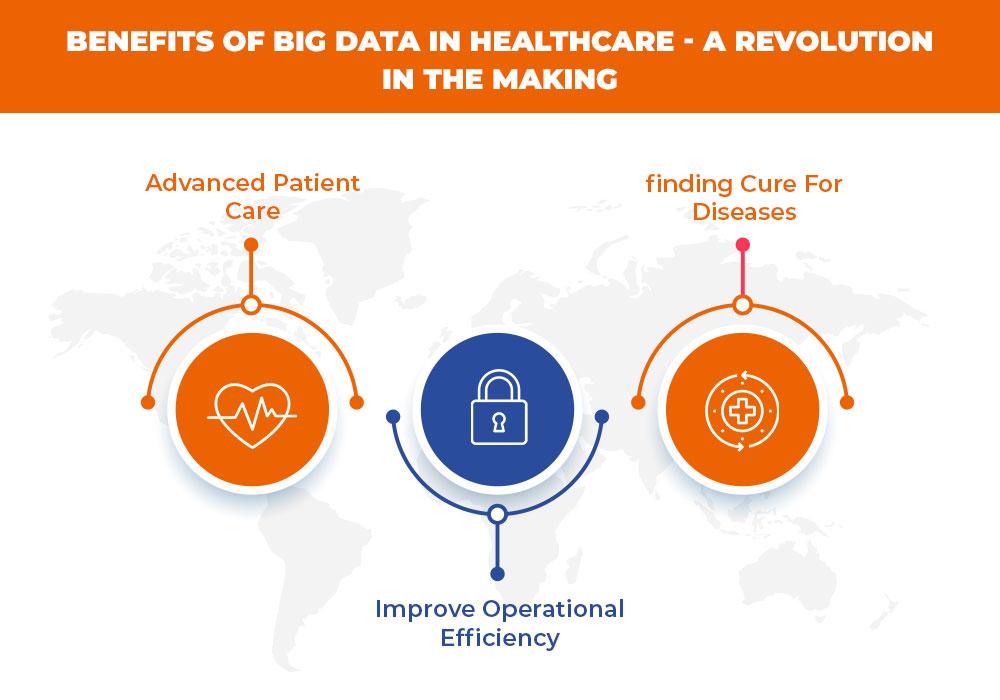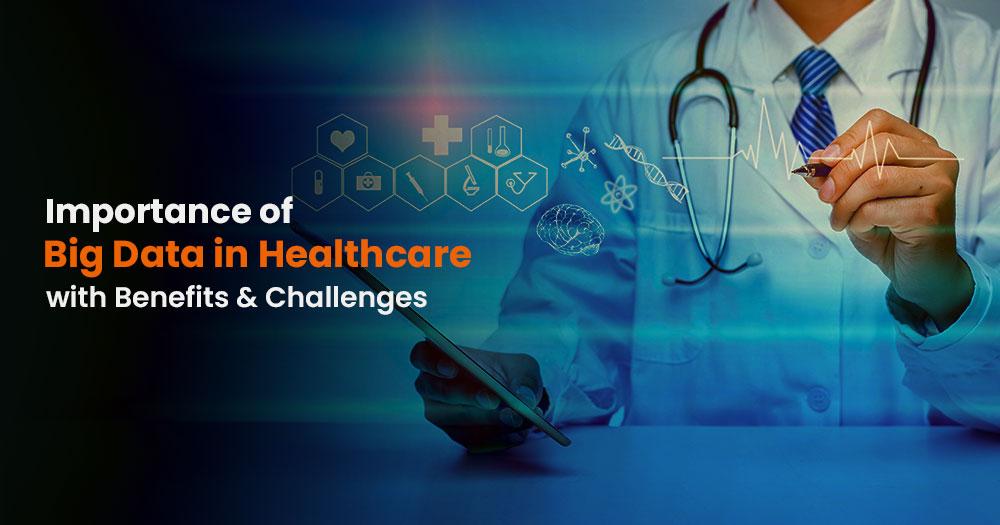Big data in Healthcare relates to using prescriptive, predictive, and descriptive analytics services to derive profound insights from healthcare data. The three objectives of big data in Healthcare are as follows:
- Utilize patient data to enhance clinical results;
- Increase workforce productivity by utilizing operational data;
- Utilize financial information about Healthcare to increase a practice, hospital, or other healthcare organization’s revenue flow.
What is Big Data?
Big data is typically understood to be a sizable collection of complex data, whether unorganized or structured can be used to solve business problems and unearth new levels of understanding previously unattainable through traditional software or analytics. Data scientists typically use analytics powered by artificial intelligence to constructively evaluate these large datasets to identify patterns and trends that can yield valuable business insights.
What is Big Data in Healthcare?
Big data in Healthcare refers to the gathering, examining, and using consumer, patient, physical, and clinical data that is too large or complex to be understood by conventional data processing techniques. Instead, data scientists and machine learning algorithms are frequently used to process big data and analytics in healthcare.

The growth of value-based care and the digitization of medical records has prompted the industry to use data analytics to inform strategic business decisions, leading to the rise of big data in Healthcare. Health systems must adopt technology capable of gathering, storing, and analyzing this data to produce actionable insights to meet the challenges of healthcare data, such as volume, velocity, variety, and veracity.
You may also like to read about A Comprehensive Guide on Big Data in the Cloud Computing
Benefits of Big Data in Healthcare

- Assemble a comprehensive, 360-degree view of patients, consumers, and doctors.
- Utilizing detailed patient profiles will enhance the personalization and effectiveness of care.
- Find geographical areas with a lot of room for expansion.
- Monitoring general practitioner preferences, referrals, and clinical appointment data can help physician relationship management.
- Information on consumer, patient, and physician needs and preferences can help healthcare marketers.
- Make it simple to identify trends in patient satisfaction, health outcomes, and hospital expansion.
- Enhance Healthcare’s effectiveness, personalization, and efficiency to maximize hospital growth.
Importance of Big Data in Healthcare
Big data has grown in importance in Healthcare due to three significant changes in the sector: the vast amount of data now available, rising healthcare costs, and a focus on consumerism. Big data and artificial intelligence in healthcare empower health systems to seize these chances to deliver individualized patient journeys and top-notch care.
Increasing Volume of Healthcare Data: The virtual data that healthcare systems had to manage dramatically increased when medical records went digital. Besides EHRs, numerous data sources include wearable technology, mobile applications, digital marketing initiatives, social media, and more. It results in an enormous amount of data, which motivates healthcare systems to implement extensive data systems and technologies to gather, examine, and utilize this data efficiently.
Growing Healthcare Costs: The cost of Healthcare has increased significantly in the past 20 years in the United States. In today’s world, Healthcare costs a total of $3.4 trillion, or about 18% of GDP. Government regulations and lifestyle choices both play a role in this. Healthcare organizations will discover quantifiable ways to boost productivity and efficiency by collecting and analyzing vast amounts of data. It encourages greater patient satisfaction and your capacity to increase market share.
How can Big Data accelerate growth initiatives?
Propensity models are developed using big data analytics in healthcare, which enhances marketing outreach and directs the best following action discovery pathways. Propensity frameworks are a subset of big data statistical analyses that are used to estimate the probability that an event will take place. Marketing departments can use propensity models to score potential targets and pinpoint those most likely to respond to particular campaigns and messaging. Marketing professionals can increase response rates and reduce wasteful spending by using more precise campaign targeting. Healthcare marketers can assess market dynamics using guided discovery pathways without specifying a specific service line. Marketing teams can highlight profitable opportunities by combining various data about regions, doctors, and patients, creating a high growth potential.
Healthcare marketers must prioritize communication personalization in a world of value-based Healthcare. Marketers develop well-informed, personalized marketing messages based on a sizable consumer and patient data database. Customers are more likely to establish and maintain an ongoing relationship with health systems when they engage in relevant and personalized communication. Integrating communication contributes to creating holistic customer experiences throughout the entire care continuum. Call centers, email, patient portals, and other marketing communication platforms must be transformed into strategic engagement entities with the help of healthcare big data companies. For instance, call center agents with easy access to patient and customer information can have informed and tailored conversations based on their prior interactions with the healthcare system. Creating holistic experiences all over care touch points increases customer satisfaction and engagement.
Challenges arise with Big Data in Healthcare.
Sorting and prioritizing information about big data in Healthcare is a significant challenge. Because there are so many data possibilities, it can frequently take time to decide which data points and insights are helpful. As a result, many businesses use artificial intelligence (AI) or machine learning to process this data quickly. Another challenge is ensuring the right people can access significant data insights and analysis to work intelligently. Even though healthcare data is gathered from numerous systems, organizations must ensure that key personnel in the sector have full access to the data. Heterogeneous or incomplete claims data present a variety of data analysis difficulties.
- Data is frequently very “noisy,” and practices, groups, or even service line specialities can be inconsistent. Billing systems need to be more cohesive and updated. Data should not replace interactions and targeted outreach to physicians; instead, it should be taken into account alongside your local geographic market knowledge.
- Patients do not each have a unique patient identifier; otherwise, data matching wouldn’t be necessary. Data matching tools are required to find these anomalies and combine the appropriate patient claims until then.
- Uncertainty in diagnosis and procedure codes – Even industry-standard grouper tools sometimes misrepresent or obscure doctor activity. You must support directional data and learn to use it because it is difficult to obtain perfect data and insights.
- Claims data needs to be more consistent; there is little chance that any field data not necessary for payment will be completed correctly. The “rendering physician” via the NPI1 for that provider is one of the few required fields for billing, along with client, diagnosis, and procedure information.
- It’s challenging to locate the referring doctor – On the available third-party claims, the “referring physician” field is frequently incomplete, inaccurate, or both. Due to these discrepancies, some clearinghouses even choose not to provide the “referring physician” file.
Future of Big Data in Healthcare
Healthcare organizations will use big data more frequently in the future as its importance to success increases. Big data analytics in Healthcare will also help to make advertising touchpoints cleverer and more integrated in the future. Additionally, as wearable internet technology of Things (IoT) gains popularity, the amount of available data will increase. Continuous patient monitoring through the IoT and wearable technology will become the norm and add a tonne of data to big data stores. With this knowledge, healthcare marketers can incorporate a variety of healthcare insights to identify and keep clients with the highest propensity to purchase services.
Impact of Big Data on Healthcare
Overall solid business results depend on intense customer experiences. Using big data analytics in healthcare to fine-tune your customer service strategy is one way to enhance the customer experience. However, significant data advantages for your company go beyond just improving customer service. The organization can use analytics to lower the cost of various services and goods.
Big data is essential for all industries but crucial for the modern, dynamic healthcare sector. Because Healthcare has many facets, big data analytics in healthcare can impact many areas. Big data can be used by hospitals and insurers alike to improve patient outcomes more competitively while reducing unnecessary costs to the company. The Council of Economic Advisers (CEA) estimates that the US healthcare sector currently accounts for about 18% of GDP. Leveraging big data directly relates to the opportunity for businesses and hospitals to cut costs and improve patient care. A crucial piece of the puzzle is comprehending how to interpret these vast amounts of data to meet the customer’s needs.
Conclusion
Big data is a vast collection of information on a particular subject. Big data refers to information created, analyzed, and stored on a scale that is too great to handle by conventional information storage systems. The move to digitize records and the quick advancement of medical technology has significantly impacted health care. A substantial portion of the big data generated by biomedical research on public health can be used to create helpful information for patients, physicians, administrators, and researchers. For instance, big data can be produced by public health researchers to forecast and get ready for potential pandemics.


